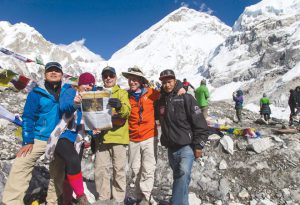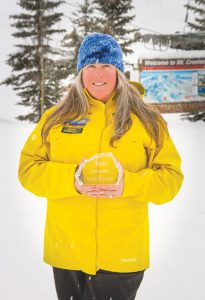“My main goal is taking neighbors to my home”
by Crystal Kotowski
Tibetan natives call Mount Everest Chomolungma, meaning “Goddess Mother of the Earth.” In Nepalese, her name is Sagarmatha, or “Mother of the Sky.” And in Crested Butte, perhaps our Everest, Mount Emmons, is the Red Lady. Buttian adoration of mountains mirrors those who have laid eyes upon Everest—just as the quest to go higher is shared in both parts of the world.
Last fall, three Buttians, Kayla Goodyear, Greg Hunt, and Nathan Bilow, heeded the challenge of the ultimate Everest trek to the base camp, seeking also to assist in earthquake reconstruction when possible. They were guided by “our local Sherpa,” Pemba Sherpa. The route has the reputation of being the grandest walk in the Himalayas.

With his hearty laugh and palpably warm heart, Sherpa—and his family—has allowed Buttians the opportunity to attain a glimpse into the Nepali ethos. Through sharing native cuisine at the Sherpa Café and offering treks throughout the Himalayas with his company, Alpine Adventures, the Sherpas are further cultivating the connections between the communities.
Through high alpine valleys below the Himalayas’ towering peaks, sporadically visible through the fog, the motley crew, Goodyear, a 23-year-old student, Hunt, a 68-year-old retired AT&T employee, and Bilow, a 59-year-old photojournalist, trekked to their destination of Everest’s Base Camp (17,590 feet) with Sherpa.
Distilling the documentation of the journey from 6,500 photos and 860 video takes into a 30-minute film to be debuted at the Crested Butte Film Festival is no easy task. But the crew hopes to do just that, sharing the beauty of Nepal with the Colorado community, and to inspire others to travel and find shared commonalities with fellow  mountain people.
mountain people.
“With the snail pace of the government involved in helping rebuild from the earthquake, it’s up to the people to create their own way of rebuilding. So that’s why I am going again, to complete a dream as a mountain adventurer, to help our neighbors on the other side of the world,” shared Bilow.
Sherpa became a porter at 11 years old, beginning his lifelong career in the trekking business—learning how to cook in the lodge kitchens along the trekking routes. In 1996, Nepalese civil war began, lasting 10 years. Throughout the war, the government controlled the main cities and towns while the Maoists dominated the countryside. More than 19,000 people were killed and an estimated 100,000 to 150,000 people were internally displaced. Nepal’s greatest source of foreign currency—its tourism industry—greatly suffered. Near the beginning of the war, Sherpa decided that he wanted to move to the U.S.
Sherpa’s brother cultivated the first connection to Crested Butte through a trekking organization in which he was a guide. His employer wrote to sponsor him, inviting him to Crested Butte. After he moved to Crested Butte, and in the midst of political turmoil and lack of opportunities in Nepal, the Sherpas soon followed. Sherpa has continued to share the Himalayas through Alpine Adventures.
“My main goal is taking neighbors to my home,” shared Sherpa, who cannot remember or quantify how many treks he has led throughout his life. He has climbed Mount Everest twice and was trekking Makalu, the world’s fifth highest peak, when the 2015 earthquake hit. Living in Gunnison County, Sherpa has found another mountain-loving community eager to climb new heights.
From October 5 to October 25, the Gunnison County crew traveled past monasteries, teahouses, and swing bridges, and alongside yaks, glaciers, prayer wheels, and trails lined with mani stones, engraved with Tibetan Buddhist prayers—experiencing not only the magnificence of the mountains, but the warmth of Sherpa culture. The trek climbs through the Khumbu Valley and follows the footsteps of the Everest summiteers.
One of the objectives was to assist in reconstruction from the earthquake where possible, offer about a dozen winter coats donated by Western State Colorado University and Adaptive Sports, and deliver funds raised in Gunnison to local monasteries.
“It was so nice seeing Pemba be so happy where he comes from. Pemba saw family in every teahouse,” said Goodyear, noting their ritual teahouse visits several times a day.
“There’s a teahouse every five seconds,” Sherpa echoed.
“Of course there’s dealing with the yaks—you have to go on the inside of the trail so they wouldn’t push you off the cliff. They don’t really bother you, but you don’t want to take any chances,” added Hunt.
There are two trekking seasons, the spring and the fall. As the mountains create their own environment of beauty and safety, it’s a fine balance of being on a ridge knowing the weather is coming in and having to take shelter. So Pemba brings his clients to places where he is welcomed and so are his guests.
“During a trekking day of four to seven hours, Pemba makes a call to the town where we can stay the night. It’s all about connecting with the people of the country as he translates everything that is necessary—though most accommodation owners speak different languages, French, German and English, besides Nepalese and Sherpa,” said Bilow.
“Some of the porters are almost super-human,” said Hunt, noting how porters are paid by the weight carried each day.
The legendary Khumbu Ice Fall and summit Kala Patar, at over 18,000 feet in elevation, greeted the trekkers as they reached base camp, as well as unobstructed views of Everest.
From the Himalayas to the Rockies, the transition home for the Buttians might not have been as difficult as for others. But the trek had apparent impacts on them all—from challenging their values, inciting reevaluation of priorities and instilling a deeper sentiment of interconnection.
“What I get from traveling is that we’re all quite similar. People all around the world are dealing with the same things… there’s a real link between this community and Nepal because of similar lifestyles and beliefs,” said Hunt.
“I think it’s important for young people to travel—for me, traveling has created different pathways in my brain. It’s important for human development. We were lucky to go with someone who is native in both Nepal and Colorado,” said Goodyear.
Pemba is organizing a mission volunteer trek April 9-30 to help rebuild the Khumbu Valley, devastated in the earthquake. Pemba also plans to start offering treks throughout the Rocky Mountains this year. Contact Alpine Adventures at (720) 273-7158 for more information. Start working out and book a trip.
 The Crested Butte News Serving the Gunnison Valley since 1999
The Crested Butte News Serving the Gunnison Valley since 1999

